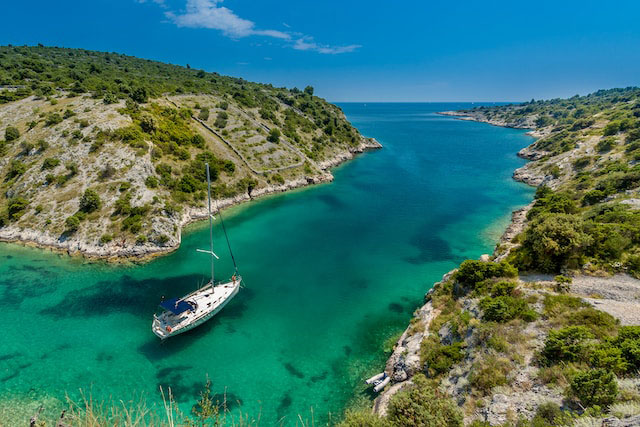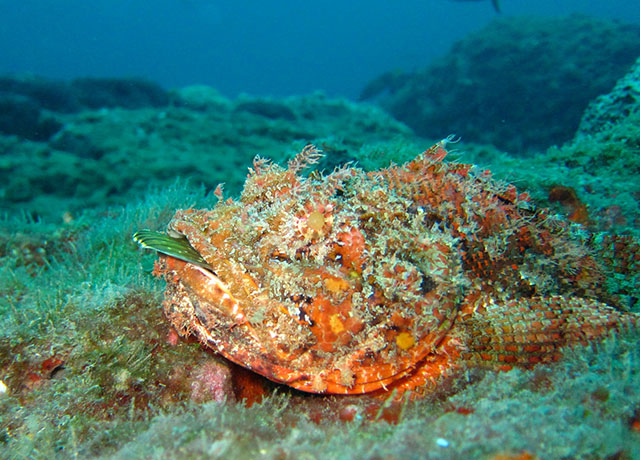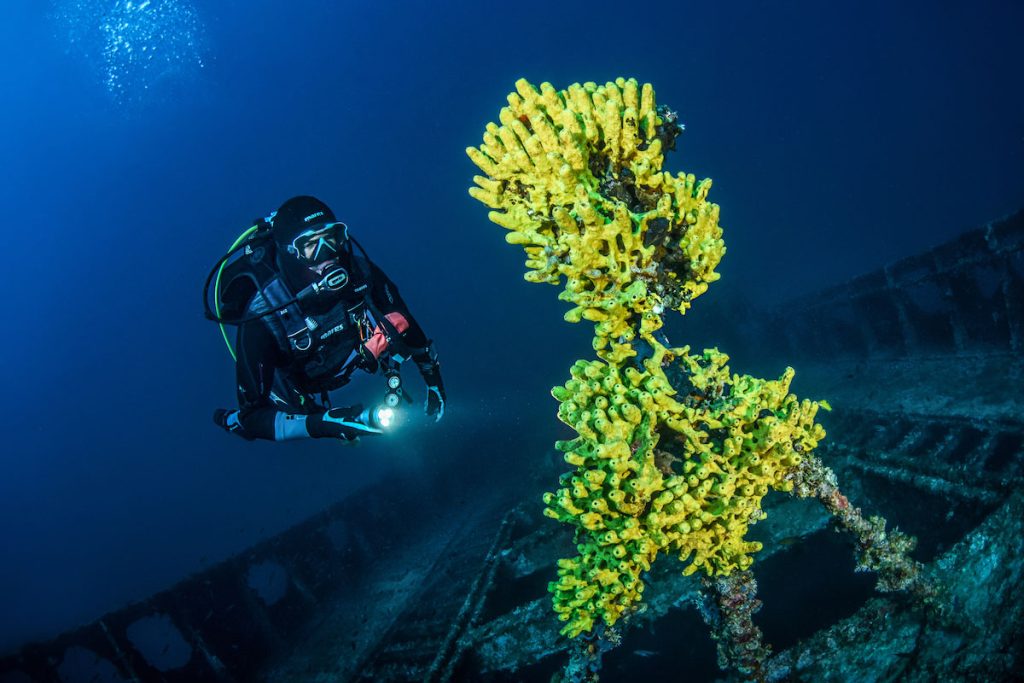With over 1000 islands and gorgeous beaches, plus a warm Mediterranean climate, Croatia is a paradise for a summer vacation. There is a wealth of dive sites to choose from and Croatia boasts an impressive range of wrecks for every experience level. Dive in and you can embark on a journey through maritime history and surface to the beautiful landscapes Croatia is famous for. Read on for our pick of Croatia’s top wreck dives.

1. HMS Coriolanus, Istria
Among the treasures that await you in Croatia is the HMS Coriolanus, a British naval vessel with a storied past from World War II. This shipwreck is one of the most popular wrecks to dive in Istria.
The HMS Coriolanus was dismantling German mines in 1945 when a mine explosion caused her to sink rapidly. She sits upright on a flat sandy bottom and is now a thriving artificial reef full of marine life. There are schools of sardines, large conger eels, lobsters, bream, and more to encounter at this fascinating wreck. Keep an eye out for passing eagle rays there as well.
With a maximum depth of 27 meters, this wreck is suitable for advanced divers.
2. Giuseppe Dezza, Istria
The Giuseppe Dezza, a torpedo ship from World War II, was sunk in 1944 by a British aircraft. The explosion was so strong that it broke the ship in half, and the stern and bow now lie on the seabed around 45 meters apart.
The stern is the most interesting part of the wreck; it has well-preserved guns and is covered in marine life, including vivid seaweeds and sponges. There is also plenty of fish life at this wreck
Sitting at a maximum depth of around 32 meters, the Giuseppe Dezza is suitable for advanced divers.
3. Baron Gautsch, Istria
A very popular wreck in Istria, the Baron Gautsch was a luxury passenger ship that met its fate in 1914. It is often referred to as the ‘Titanic of the Adriatic’ and offers an exceptional wreck diving experience.
The ship’s history dates back to the grandeur of a bygone era, where opulence and elegance were the norm. As you descend, you’ll be greeted by an imposing 84-meter-long ship covered in sponges and seaweeds. The wreck interior hosts diverse marine life, including conger eels, scorpion fish, and nudibranchs. There are also shoaling fish in the surrounding waters.

This wreck sits upright at around 40 meters deep, with an upper deck at 28 meters.
There can be large waves at this dive site, making it best suited to experienced divers.
4. Brioni, Split-Dalmatia
The Brioni may be small at just 8 meters long, but she is one of the most captivating wrecks in Croatia. This passenger and cargo ship off the island of Vis was built in 1909 and sank in 1930 when she was carrying tobacco and wine from Split to Vis.
The Brioni rests on her side at around 40 meters deep, with the bow at 60 meters, and is densely covered in bright yellow sponges. The visibility is usually good at this dive site, making it easy to find as you descend. There are walls close to the wreck that host plentiful life, including lobsters and even parrotfish. To fully enjoy this beautiful wreck, make sure you do at least two dives there.
Given the depth range of 40 to 60 meters, this wreck is a good choice for tech diving.
5. Vassilios, Split-Dalmatia
You can explore the remnants of Greece’s maritime legacy when you dive the Vassilios, a Greek cargo ship that met its fate in 1939. This 105-meter-long steamer hit the rocks when she was transporting coal from Swansea to Venice and sank immediately.
Submerged off the coast of Split-Dalmatia, this shipwreck is an interesting dive for intermediate to experienced divers. You can still see coal in the open cargo holds, there is a huge propeller, and the masts create an impressive site during your dive; they are covered in yellow and orange sponges.
As well as numerous crustaceans, the wreck hosts large scorpion fish and eels. Decompression stops are made on a rocky slope nearby, which hosts a variety of brightly-coloured nudibranchs.
At 20 to 55 meters deep, this wreck is suitable for advanced divers through to technical divers.
6. B-24 Liberator, Split-Dalmatia
For something different, explore the wreckage of the B-24 Liberator, a bomber plane from World War II. This plane was the last of its kind ever to be made in the Douglas Factory in Tulsa, Oklahoma, and was given the nickname Tulsamerican.

The Croatia B-24 was bought by factory employees and local citizens and bears the names of all the people who helped to create it. It crashed in 1944 but it wasn’t discovered until 2009, when a diver accidentally found it.
The B-24 lies upside down and is encrusted with brightly-coloured marine life. The main sections of the wreck include the cockpit, four engines, and wings. A deeper section of the wreck consists of the tail and a propeller.
This dive site is offshore and can have strong currents.
The B-24 lies at 37 to 52 meters deep, making it a good wreck for technical divers.
7. Taranto, Dubrovnik
The Taranto, an Italian merchant shipwreck, offers a glimpse into World War II history. This ship was built in Rotterdam in 1899 and was a trading vessel, subsequently used during World War II to transport military provisions. She sank in 1943 whilst carrying flour and tractors.
Covered in sponges and anemones, and surrounded by schools of mullet and cardinal fish, this is a beautiful wreck to dive. The wreck lies at a 45-degree angle and is well preserved, with two tractors next to it on the sandy seabed. You can still see the ship’s steam engine and a 10-meter-high chimney rising up from the depths.
With a maximum depth of 51 meters, this wreck is suitable for experienced divers only.

8. Diving in Croatia’s underwater museums
Whilst you’re there, make sure you also leave time to explore Croatia’s underwater museums. The Lošinj Historical Underwater Park features artefacts at 5 to 15 meters deep, including anchors from the 4th and 5th centuries, Venetian cannons, and machine guns from World War II. The Via Crucis underwater museum has a collection of over 50 life-sized statues, sitting at 4 to 12 meters deep in crystal-clear blue waters. Both offer unique and peaceful places to dive.
Croatia’s historical dive sites preserve the tales of times long gone, and invite you to connect with history beneath the waves. Whether you’re drawn to naval conflicts, maritime trade, or wartime intrigue, diving in Croatia offers a fascinating window into the past.
Kathryn Curzon, a dive travel writer for SSI (Scuba Schools International), wrote this article.
Image credits:
- Wreck diving in Croatia: SSI | All Rights Reserved
